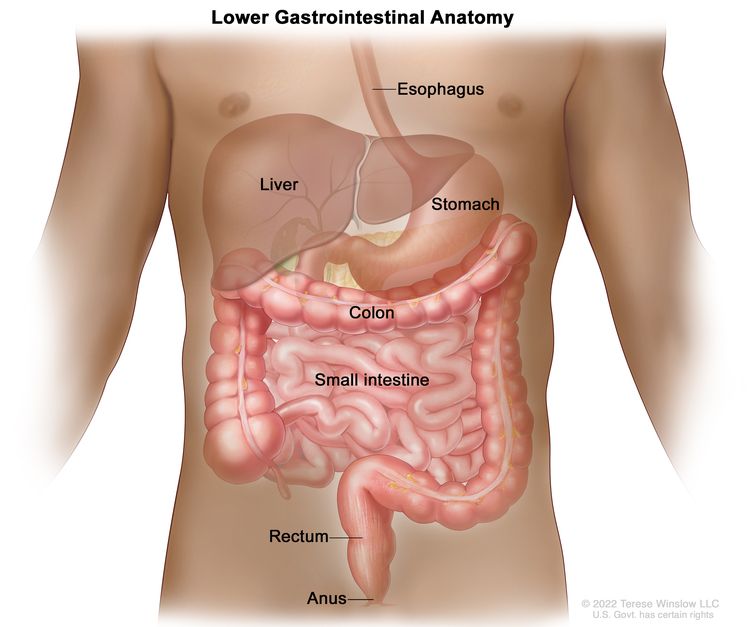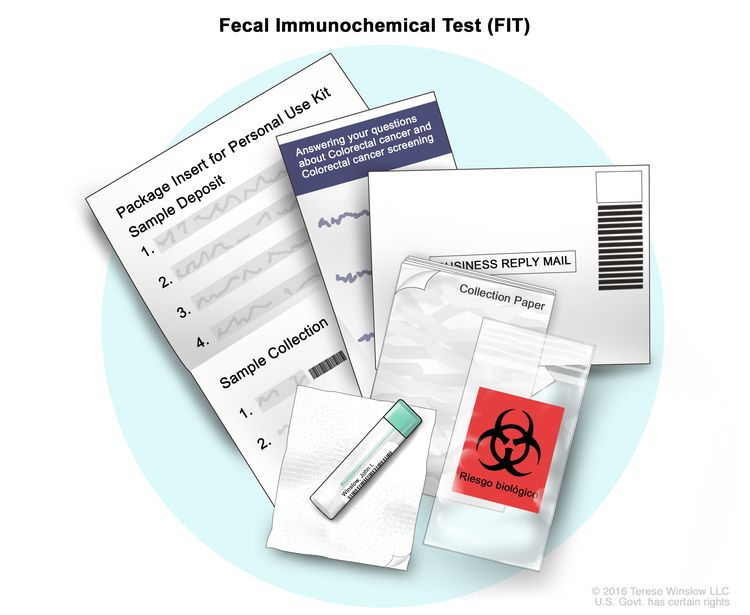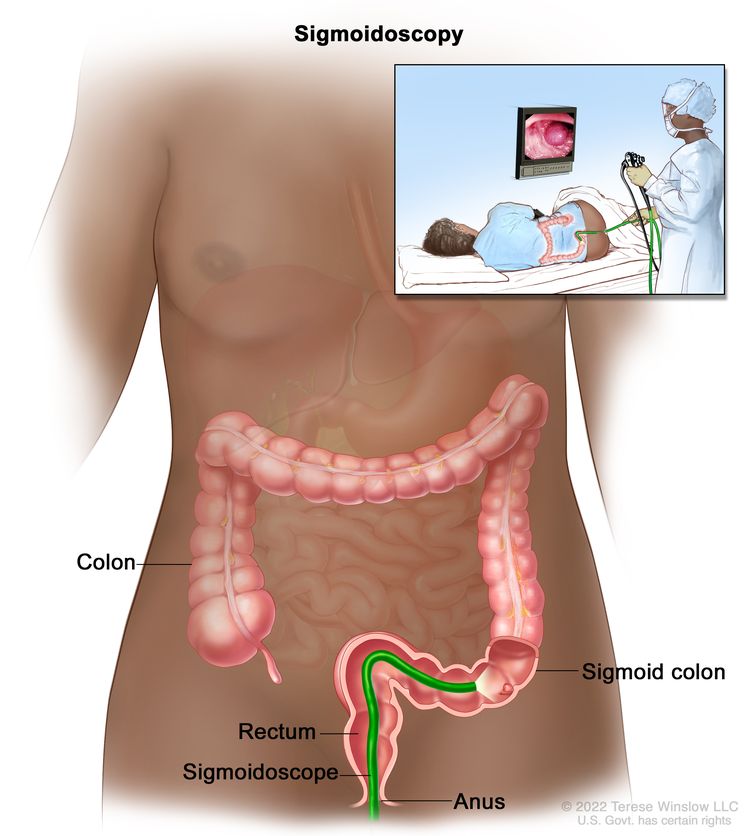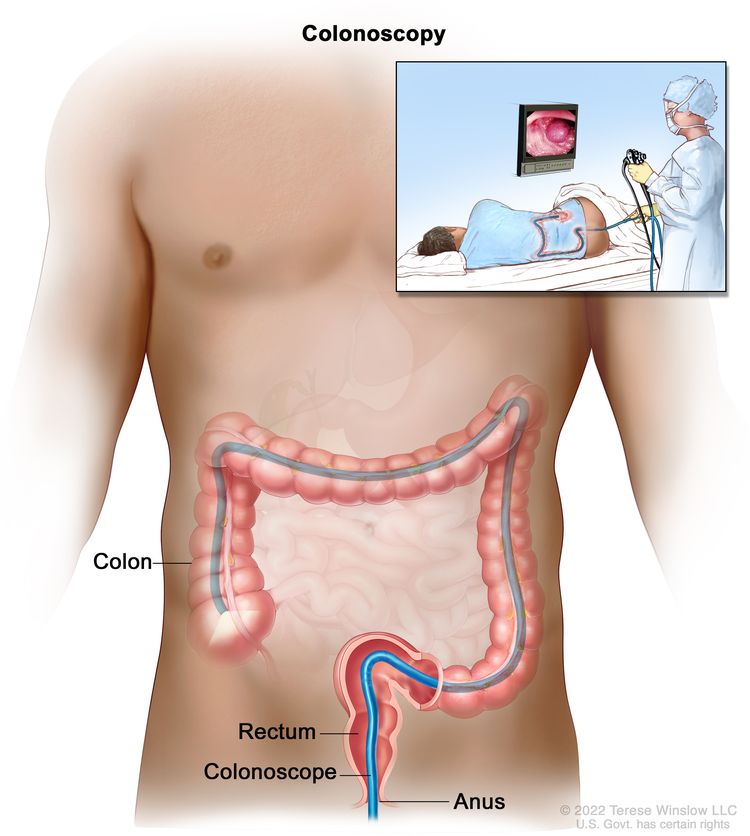National Cancer Institute
Post Date: Oct 19, 2023
There are five types of tests that are used to screen for colorectal cancer: fecal occult blood test, sigmoidoscopy, colonoscopy, virtual colonoscopy, and DNA stool test. Learn more about these and other tests in this expert-reviewed summary.
Colorectal Cancer Screening
What is screening?
Screening is looking for cancer before a person has any symptoms. This can help find cancer at an early stage. When abnormaltissue or cancer is found early, it may be easier to treat. By the time symptoms appear, cancer may have begun to spread.
Scientists are trying to better understand which people are more likely to get certain types of cancer. They also study the things we do and the things around us to see if they cause cancer. This information helps doctors recommend who should be screened for cancer, which screening tests should be used, and how often the tests should be done.
It is important to remember that your doctor does not necessarily think you have cancer if he or she suggests a screening test. Screening tests are given when you have no cancer symptoms. Screening tests may be repeated on a regular basis.
If a screening test result is abnormal, you may need to have more tests done to find out if you have cancer. These are called diagnostic tests.
General Information About Colorectal Cancer
Key Points for this Section
- Colorectal cancer is a disease in which malignant (cancer) cells form in the tissues of the colon or the rectum.
- Colorectal cancer is the third leading cause of death from cancer in the United States.
- Different factors increase or decrease the risk of getting colorectal cancer.
Colorectal cancer is a disease in which malignant (cancer) cells form in the tissues of the colon or the rectum.
The colon and rectum are parts of the body's digestive system. The digestive system removes and processes nutrients (vitamins, minerals, carbohydrates, fats, proteins, and water) from foods and helps pass waste material out of the body. The digestive system is made up of the mouth, throat, esophagus, stomach, and the small and large intestines. The colon (large bowel) is the first part of the large intestine and is about 5 feet long. Together, the rectum and anal canal make up the last part of the large intestine and are 6-8 inches long. The anal canal ends at the anus (the opening of the large intestine to the outside of the body).
 Anatomy of the lower gastrointestinal (digestive) system showing the colon, rectum, and anus. Other organs that make up the digestive system are also shown.
Anatomy of the lower gastrointestinal (digestive) system showing the colon, rectum, and anus. Other organs that make up the digestive system are also shown.
Cancer that begins in the colon is called colon cancer, and cancer that begins in the rectum is called rectal cancer. Cancer that begins in either of these organs may also be called colorectal cancer.
Other PDQ summaries containing information related to colorectal cancer include the following:
- Colorectal Cancer Prevention
- Colon Cancer Treatment
- Rectal Cancer Treatment
- Genetics of Colorectal Cancer
Colorectal cancer is the third leading cause of death from cancer in the United States.
Between 2011 and 2019, the number of new colorectal cancer cases in the United States decreased slightly per year in patients aged 50 years and older, due to increased screening for colorectal cancer. In patients younger than 50 years, the number of new colorectal cancer cases increased slightly per year. From 2012 to 2020, deaths from colorectal cancer declined slightly each year. Colorectal cancer is found more often in men than in women.
Different factors increase or decrease the risk of getting colorectal cancer.
Anything that increases your chance of getting a disease is called a risk factor. Anything that decreases your chance of getting a disease is called a protective factor.
For more information about risk factors and protective factors for colorectal cancer, see Colorectal Cancer Prevention.
Colorectal Cancer Screening
Key Points for this Section
- Tests are used to screen for different types of cancer when a person does not have symptoms.
- Studies show that some screening tests for colorectal cancer help find cancer at an early stage and may decrease the number of deaths from the disease.
- The following types of tests are used to screen for colorectal cancer:
- Fecal occult blood test
- Sigmoidoscopy
- Colonoscopy
- Virtual colonoscopy
- DNA stool test
- Studies have shown that screening for colorectal cancer using digital rectal exam does not decrease the number of deaths from the disease.
- Screening tests for colorectal cancer are being studied in clinical trials.
Tests are used to screen for different types of cancer when a person does not have symptoms.
Scientists study screening tests to find those with the fewest harms and most benefits. Cancer screening trials also are meant to show whether early detection (finding cancer before it causes symptoms) helps a person live longer or decreases a person's chance of dying from the disease. For some types of cancer, the chance of recovery is better if the disease is found and treated at an early stage.
Studies show that some screening tests for colorectal cancer help find cancer at an early stage and may decrease the number of deaths from the disease.
The following types of tests are used to screen for colorectal cancer:
Fecal occult blood test
A fecal occult blood test (FOBT) is a test to check stool (solid waste) for blood that can only be seen with a microscope. A small sample of stool is placed on a special card or in a special container and returned to the doctor or laboratory for testing. Blood in the stool may be a sign of polyps, cancer, or other conditions.
There are two types of FOBTs:
- Guaiac FOBT: The sample of stool on the special card is tested with a chemical. If there is blood in the stool, the special card changes color.
 A guaiac fecal occult blood test (FOBT) checks for occult (hidden) blood in the stool. Small samples of stool are placed on a special card and returned to a doctor or laboratory for testing.
A guaiac fecal occult blood test (FOBT) checks for occult (hidden) blood in the stool. Small samples of stool are placed on a special card and returned to a doctor or laboratory for testing. - Immunochemical FOBT: A liquid is added to the stool sample. This mixture is injected into a machine that contains antibodies that can detect blood in the stool. If there is blood in the stool, a line appears in a window in the machine. This test is also called fecal immunochemical test or FIT.
 A fecal immunochemical test (FIT) checks for occult (hidden) blood in the stool. A small sample of stool is placed in a special collection tube or on special cards and returned to a doctor or laboratory for testing.
A fecal immunochemical test (FIT) checks for occult (hidden) blood in the stool. A small sample of stool is placed in a special collection tube or on special cards and returned to a doctor or laboratory for testing.
Sigmoidoscopy
Sigmoidoscopy is a procedure to look inside the rectum and sigmoid (lower) colon for polyps, abnormal areas, or cancer. A sigmoidoscope is inserted through the rectum into the sigmoid colon. A sigmoidoscope is a thin, tube-like instrument with a light and a lens for viewing. It may also have a tool to remove polyps or tissue samples, which are checked under a microscope for signs of cancer.
 Sigmoidoscopy. A thin, lighted tube is inserted through the anus and rectum and into the lower part of the colon to look for abnormal areas.
Sigmoidoscopy. A thin, lighted tube is inserted through the anus and rectum and into the lower part of the colon to look for abnormal areas.
Colonoscopy
Colonoscopy is a procedure to look inside the rectum and colon for polyps, abnormal areas, or cancer. A colonoscope is inserted through the rectum into the colon. A colonoscope is a thin, tube-like instrument with a light and a lens for viewing. It may also have a tool to remove polyps or tissue samples, which are checked under a microscope for signs of cancer.
 Colonoscopy. A thin, lighted tube is inserted through the anus and rectum and into the colon to look for abnormal areas.
Colonoscopy. A thin, lighted tube is inserted through the anus and rectum and into the colon to look for abnormal areas.
Virtual colonoscopy
Virtual colonoscopy is a procedure that uses a series of x-rays called computed tomography to make a series of pictures of the colon. A computer puts the pictures together to create detailed images that may show polyps and anything else that seems unusual on the inside surface of the colon. This test is also called computed tomography colonography or CTC.
Clinical trials are comparing virtual colonoscopy with other colorectal cancer screening tests. Some clinical trials are testing whether drinking a contrast material that coats the stool, instead of using laxatives to empty the colon, shows polyps clearly.
DNA stool test
This test checks DNA in stool cells for genetic changes that may be a sign of colorectal cancer.
Studies have shown that screening for colorectal cancer using digital rectal exam does not decrease the number of deaths from the disease.
A digital rectal exam (DRE) is an exam of the rectum that may be done as part of a routine physical exam. A doctor or nurse inserts a lubricated, gloved finger into the lower part of the rectum to feel for lumps or anything else that seems unusual. Study results have shown that DRE does not work as a screening method for colorectal cancer.
Screening tests for colorectal cancer are being studied in clinical trials.
Information about clinical trials supported by NCI can be found on NCI’s clinical trials search webpage. Clinical trials supported by other organizations can be found on the ClinicalTrials.gov website.
Risks of Colorectal Cancer Screening
Key Points for this Section
- Screening tests have risks.
- False-negative test results can occur.
- False-positive test results can occur.
- The following colorectal cancer screening tests have risks:
- Colonoscopy
- Sigmoidoscopy
- Virtual colonoscopy
- Fecal occult blood test (FOBT) or DNA stool test
Screening tests have risks.
Decisions about screening tests can be difficult. Not all screening tests are helpful and most have risks. Different screening tests have different risks or harms. Screening tests may cause anxiety when you are thinking about or getting ready for the test, or when there is a positive test result. Before having any screening test, you may want to discuss the test with your doctor. It is important to know the risks of the test, and whether it has been proven to reduce the risk of dying from cancer.
Talk to your doctor about your risk for colorectal cancer and the need for screening tests.
False-negative test results can occur.
Screening test results may appear to be normal even though colorectal cancer is present. A person who receives a false-negative test result (one that shows there is no cancer when there really is) may delay seeking medical care even if there are symptoms.
False-positive test results can occur.
Screening test results may appear to be abnormal even though no cancer is present. A false-positive test result (one that shows there is cancer when there really isn't) can cause anxiety and is usually followed by more tests (such as biopsy), which also have risks.
The following colorectal cancer screening tests have risks:
Colonoscopy
Serious problems caused by colonoscopy are rare, but can include tears in the lining of the colon and bleeding. These problems can be serious and need to be treated in a hospital. Tearing of the lining of the colon and bleeding occur more often when a biopsy or polypectomy is done.
Sedation is used to decrease the discomfort from the procedure. Sedation may cause heart and lung problems, such as irregular heartbeat, heart attack, or trouble breathing.
Sigmoidoscopy
There are fewer complications with a sigmoidoscopy than with a colonoscopy. Although tears in the lining of the colon and bleeding can occur, they are less common than with a colonoscopy. There is usually no sedation with sigmoidoscopy, lowering the risk of complications.
Virtual colonoscopy
Virtual colonoscopy has fewer possible physical harms than either colonoscopy or sigmoidoscopy. The harms of being exposed to radiation from x-rays used in virtual colonoscopy are not known. Virtual colonoscopy often finds problems with organs other than the colon, including the kidneys, chest, liver, ovaries, spleen, and pancreas. Some of these findings lead to more testing, such as colonoscopy, that may not improve the patient's health.
Fecal occult blood test (FOBT) or DNA stool test
The results of an FOBT or DNAstool test may appear to be abnormal even though no cancer is found. A positive test result may lead to more testing, including colonoscopy.
About This PDQ Summary
About PDQ
Physician Data Query (PDQ) is the National Cancer Institute's (NCI's) comprehensive cancer information database. The PDQ database contains summaries of the latest published information on cancer prevention, detection, genetics, treatment, supportive care, and complementary and alternative medicine. Most summaries come in two versions. The health professional versions have detailed information written in technical language. The patient versions are written in easy-to-understand, nontechnical language. Both versions have cancer information that is accurate and up to date and most versions are also available in Spanish.
PDQ is a service of the NCI. The NCI is part of the National Institutes of Health (NIH). NIH is the federal government’s center of biomedical research. The PDQ summaries are based on an independent review of the medical literature. They are not policy statements of the NCI or the NIH.
Purpose of This Summary
This PDQ cancer information summary has current information about colorectal cancer screening. It is meant to inform and help patients, families, and caregivers. It does not give formal guidelines or recommendations for making decisions about health care.
Reviewers and Updates
Editorial Boards write the PDQ cancer information summaries and keep them up to date. These Boards are made up of experts in cancer treatment and other specialties related to cancer. The summaries are reviewed regularly and changes are made when there is new information. The date on each summary ("Updated") is the date of the most recent change.
The information in this patient summary was taken from the health professional version, which is reviewed regularly and updated as needed, by the PDQ Screening and Prevention Editorial Board.
Clinical Trial Information
A clinical trial is a study to answer a scientific question, such as whether one treatment is better than another. Trials are based on past studies and what has been learned in the laboratory. Each trial answers certain scientific questions in order to find new and better ways to help cancer patients. During treatment clinical trials, information is collected about the effects of a new treatment and how well it works. If a clinical trial shows that a new treatment is better than one currently being used, the new treatment may become "standard." Patients may want to think about taking part in a clinical trial. Some clinical trials are open only to patients who have not started treatment.
Clinical trials can be found online at NCI's website. For more information, call the Cancer Information Service (CIS), NCI's contact center, at 1-800-4-CANCER (1-800-422-6237).
Permission to Use This Summary
PDQ is a registered trademark. The content of PDQ documents can be used freely as text. It cannot be identified as an NCI PDQ cancer information summary unless the whole summary is shown and it is updated regularly. However, a user would be allowed to write a sentence such as “NCI’s PDQ cancer information summary about breast cancer prevention states the risks in the following way: [include excerpt from the summary].”
The best way to cite this PDQ summary is:
PDQ® Screening and Prevention Editorial Board. PDQ Colorectal Cancer Screening. Bethesda, MD: National Cancer Institute. Updated
Images in this summary are used with permission of the author(s), artist, and/or publisher for use in the PDQ summaries only. If you want to use an image from a PDQ summary and you are not using the whole summary, you must get permission from the owner. It cannot be given by the National Cancer Institute. Information about using the images in this summary, along with many other images related to cancer can be found in Visuals Online. Visuals Online is a collection of more than 3,000 scientific images.
Disclaimer
The information in these summaries should not be used to make decisions about insurance reimbursement. More information on insurance coverage is available on Cancer.gov on the Managing Cancer Care page.
Contact Us
More information about contacting us or receiving help with the Cancer.gov website can be found on our Contact Us for Help page. Questions can also be submitted to Cancer.gov through the website’s E-mail Us.